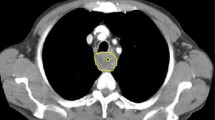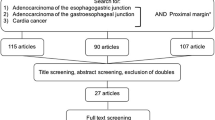Abstract
To compare the accuracy of determining the most appropriate treatment approach based on a visual analysis on combined PET-CT, based on a visual analysis on PET (reviewed side-by-side with CT) and based on tumour length measurements (on PET and PET-CT). Tumour length, SUV, and the length-SUV index (length × SUV) were assessed (on PET and PET-CT) in benign oesophageal lesions (reflux oesophagitis; n = 29), in potentially curable stages of oesophageal cancer (Tis; T1-T3NxM0; curable group; n = 52), and in stages of oesophageal cancer best treated with palliative therapy (T4NxMx; TxNxM1; palliative group; n = 30). All lesions were histopathologically proven. Based on a visual analysis, PET-CT (sensitivity: 77%;specificity: 96%) was more accurate than PET (sensitivity: 67%; specificity: 89%) in assessing the appropriate treatment (curative vs. palliative). The length-SUV index was the most accurate quantitative parameter to distinguish palliative from curable stages (sensitivity: 93%; specificity: 90%) and to predict survival. The highest overall accuracy was reached when combining the results of the quantitative (length-SUV index) analysis with those of the qualitative (visual) analysis (sensitivity: 93%; specificity: 96%). Moreover, neither tumour length nor SUV can be used to distinguish reflux oesophagitis from early malignant lesions (T1 stage). Tumour length measured with PET-CT or PET is associated with stage and overall survival of oesophageal cancer and helps to guide the appropriate treatment approach.


Similar content being viewed by others
References
Eloubeidi MA, Desmond R, Arguedas MR, Reed CE, Wilcox CM (2002) Prognostic factors for the survival of patients with esophageal carcinoma in the U.S.: the importance of tumor length and lymph node status. Cancer 95:1434–1443
Gill PG, Denham JW, Jamieson GG, Devitt PG, Yeoh E, Olweny C (1992) Patterns of treatment failure and prognostic factors associated with the treatment of esophageal carcinoma with chemotherapy and radiotherapy either as sole treatment or followed by surgery. J Clin Oncol 10:1037–1043
Igaki H, Kato H, Tachimori Y, Sato H, Daiko H, Nakanishi Y (2001) Prognostic evaluation for squamous cell carcinomas of the lower thoracic esophagus treated with three-field lymph node dissection. Eur J Cardiothorac Surg 19:887–893
Urba SG, Orringer MB, Turrisi A, Iannettoni M, Forastiere A, Strawderman M (2001) Randomized trial of preoperative chemoradiation versus surgery alone in patients with locoregional esophageal carcinoma. J Clin Oncol 19:305–313
Griffiths EA, Brummell Z, Gorthi G, Pritchard SA, Welch IM (2006) Tumor length as a prognostic factor in esophageal malignancy: univariate and multivariate survival analyses. J Surg Oncol 15:258–267
Rice TW, Zuccaro G Jr, Adelstein DJ, Rybicki LA, Blackstone EH, Goldblum JR (1998) Esophageal carcinoma: depth of tumor invasion is predictive of regional lymph node status. Ann Thorac Surg 65:787–792
Rice TW, Adelstein DJ (1997) Precise clinical staging allows treatment modification of patients with esophageal carcinoma. Oncology (Williston Park) 11:58–62
Sherman CA, Turrisi AT, Wallace MB, Reed CE (2002) Locally advanced esophageal cancer. Curr Treat Options Oncol 3:475–485
Cerfolio RJ, Bryant AS, Ohja B, Bartolucci AA, Eloubeidi MA (2005) The accuracy of endoscopic ultrasonography with fine-needle aspiration, integrated positron emission tomography with computed tomography, and computed tomography in restaging patients with esophageal cancer after neoadjuvant chemoradiotherapy. J Thorac Cardiovasc Surg 129:1232–1241
Hagen JA, DeMeester SR, Peters JH, Chandrasoma P, DeMeester TR (2001) Curative resection for esophageal adenocarcinoma: analysis of 100 en bloc esophagectomies. Ann Surg 234:520–530
Walsh TN, Noonan N, Hollywood D, Kelly A, Keeling N, Hennessy TP (1996) A comparison of multimodal therapy and surgery for esophageal adenocarcinoma. N Engl J Med 335:462–467
Mamede M, El Fakhri G, Abreu-e-Lima P, Gandler W, Nosé V, Gerbaudo VH (2007) Pre-operative estimation of esophageal tumor metabolic length in FDG-PET images with surgical pathology confirmation. Ann Nucl Med 21:553–562
Konski A, Doss M, Milestone B, Haluszka O, Hanlon A, Freedman G, Adler L (2005) The integration of 18-fluoro-deoxy-glucose positron emission tomography and endoscopic ultrasound in the treatment-planning process for esophageal carcinoma. Int J Radiat Oncol Biol Phys 61:1123–1128
Choi JY, Jang HJ, Shim YM, Kim K, Lee KS, Lee KH, Choi Y, Choe YS, Kim BT (2004) 18F-FDG PET in patients with esophageal squamous cell carcinoma undergoing curative surgery: prognostic implications. J Nucl Med 45:1843–1850
Ott K, Weber WA, Lordick F, Becker K, Busch R, Herrmann K, Wieder H, Fink U, Schwaiger M, Siewert JR (2006) Metabolic imaging predicts response, survival, and recurrence in adenocarcinomas of the esophagogastric junction. J Clin Oncol 24:4692–4698
Wieder HA, Beer AJ, Lordick F, Ott K, Fischer M, Rummeny EJ, Ziegler S, Siewer JR, Schwaiger M (2005) Comparison of changes in tumor metabolic activity and tumor size during chemotherapy of adenocarcinomas of the esophagogastric junction. J Nucl Med 46:2029–2034
Dickson GH, Singh KK, Escofet X, Kelley K (2001) Validation of a modified GTNM classification in peri-junctional oesophago-gastric carcinoma and its use as a prognostic indicator. Eur J Surg Oncol 27:641–644
Korst RJ, Rusch VW, Venkatraman E, Bains MS, Burt ME, Downey RJ, Ginsberg RJ (1998) Proposed revision of the staging classification for esophageal cancer. J Thorac Cardiovasc Surg 115:660–669
Rice TW, Blackstone EH, Rybicki LA, Adelstein DJ, Murthy SC, DeCamp MM, Goldblum JR (2003) Refining esophageal cancer staging. J Thorac Cardiovasc Surg 125:1103–1113
Bhutani MS, Barde CJ, Markert RJ, Gopalswamy N (2002) Length of esophageal cancer and degree of luminal stenosis during upper endoscopy predict T stage by endoscopic ultrasound. Endoscopy 34:461–463
Van Dam J (1994) Endosonographic evaluation of the patient with esophageal carcinoma. Chest Surg Clin N Am 4:269–284
Byrne MF, Jowell PS (2002) Gastrointestinal imaging: endoscopic ultrasound. Gastroenterology 122:1631–1648
Halvorsen RA Jr, Magruder-Habib K, Foster WL Jr, Roberts L Jr, Postlethwait RW, Thompson WM (1986) Esophageal cancer staging by CT: long-term follow-up study. Radiology 161:147–151
Author information
Authors and Affiliations
Corresponding author
Rights and permissions
About this article
Cite this article
Roedl, J.B., Sahani, D.V., Colen, R.R. et al. Tumour length measured on PET-CT predicts the most appropriate stage-dependent therapeutic approach in oesophageal cancer. Eur Radiol 18, 2833–2840 (2008). https://doi.org/10.1007/s00330-008-1078-7
Received:
Revised:
Accepted:
Published:
Issue Date:
DOI: https://doi.org/10.1007/s00330-008-1078-7




